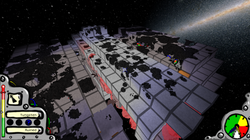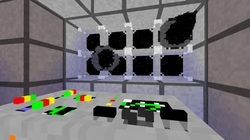Software:ScrumbleShip
ScrumbleShip is an open-world MMOG block-building space flight simulation game[1][2][3][4] in the alpha stage of development by Dirkson of OrangeHat Tech, LLC.[5][6][7][8]
Gameplay
ScumbleShip aims to be as true real-world physics as possible, while remaining true to science fiction and being fun to play.[7] ScrumbleShip is set roughly 100 to 300 years in the future. Players will gather resources, construct anything from a shuttle to a capital ship out of individual blocks, then pilot it with AI and/or real-human help against other players.[9] Players can then fly their ships from solar system to solar system mining ore, building other ships and space stations, and fighting each other in battles where damage is not only permanent but can be very deadly.[10] Players will form factions, sell ships, goods, and services to other players, and more.
Players will need to consider numerous factors in building a working ship, including: radiating heat produced by the ship's systems to space; ensuring an adequate fuel supply; keeping the ship's air breathable and contained; keeping the crew efficient and happy; ensuring the ship's power supply can meet its power demands; placing crew members in roles at which they are skilled; and more.[1] ScrumbleShip's gameplay aims to be challenging, but rewarding to players at all levels of video game competency.[11]
In ScrumbleShip, there ain't no such thing as a free lunch. The law of conservation of energy applies; everything the player builds in-game, and all energy expended must come from some existing source.[5] Players and AI crew members (redshirted clones), will need to build their ships and space stations block by block out of material mined from asteroids or salvaged from other ships. Players and clones can only carry one block at a time, as blocks are a cubic meter in volume. Players will place blueprint blocks that indicate where a clone or player should weld a new block or component, and out of which material it should be made.
Setting
The ScrumbleVerse is the universe in which ScrumbleShip takes place. The ScrumbleVerse is a persistent world. While there will not be one main server, players will be able to host their own servers which take the form of solar systems, all of which will be linked. Players who host a server will be able to run a space station hub that acts as a center for trade and repair for the solar system. This hub station will feature a warp gate that allows for instantaneous travel to other solar systems (servers) for those players whose ships cannot support a warp drive, or those who cannot afford one.
Heat simulation
As of August 12, 2012, ScrumbleShip's alpha version features heat simulation. While heat simulation has been featured in two-dimensional video games, such as falling-sand games, ScrumbleShip's heat simulation is unique among 3D computer games. Players can currently heat in-game objects using a laser. Objects transfer heat to nearby objects at a rate proportionate to the real-world thermal conductivity and thermal capacity of the materials.
As objects grow hotter, they glow red proportionate to their heat energy. Laser fire is scalable; lower-powered lasers are likely to gradually warm an object and cause it to melt and boil off. High-powered lasers are more likely to flash-boil the voxels they strike, resulting in a hole in the object and relatively little heat transferred to the surrounding material.
Objects that exceed their melting point without being flash-boiled turn into a red-hot animated blob representing melted material in zero gravity. Such blobs tend to quickly boil off, as the boiling point of a liquid is just over its melting point in a vacuum.[12] When the engine calculates an object to be boiling, the object animates to represent boiling into nothingness, and is removed.
Planned features include exothermic ship components producing heat that builds up in a ship's atmosphere and material, and requiring players who hope to build working ships to design them with heat dissipation in mind.
Voxel Damage Modelling
Unlike in other block-building games which are erroneously referred to as "voxel" games, each component and block in ScrumbleShip is composed of up to 4,096 individual voxels, which are essentially 3D pixels.
ScrumbleShip depicts damage to in-game materials accurately and precisely by removing voxels that the game calculates to have been destroyed, rather than by removing entire blocks or components. Voxels are currently destroyed when the game's heat engine calculates that a laser has brought an object's material above its boiling point. Voxels are then removed in the shape of the laser beam at a rate proportionate to the temperature of the object, the energy of the beam, and the duration of time over which the beam strikes the object.
Terminals
Terminals are the computer stations from which players and clones will control a ship's weapons, engines, sensors, and other systems. Terminals will operate on ScrumbleScript, a simple, custom-built programming language that will allow basic and advanced programs to be created. Players will be able to code and trade programs that cause various ship systems to perform certain functions under given conditions, allowing for automation of ship functions such as emergency reactor shutdown. Even functional operating systems may be created using ScrumbleScript.
Licensing
Every purchased copy of ScrumbleShip will come with a full copy of the C source code. However, the license is non-free: any redistribution, in source or binary form, verbatim or modified, is allowed "only on websites explicitly approved by Orangehat Tech, LLC. Currently the only approved website for redistribution is scrumbleship.com."[13]
Modders can contribute their original source code and voxel models for inclusion in the main build.
Bleeding Edge Releases
Bleeding edge executables are frequently broken, frequently updated executables with all the newest, untested features in them, and are equivalent to other software project's "nightlies". They are currently available as a perk for ScrumbleShip "Deluxe" owners. To install a bleeding edge release, players must unzip them and then move the files into the directory for the latest release of ScrumbleShip. Each bleeding edge is built against the current version of ScrumbleShip on the official web site's "Get" page.
They are currently limited to Win32 and Lin64 executables due to technical limitations of the developer's system. Each release comes with the full source code, however, so players can build executables for any operating system.
Funding
ScrumbleShip employs an alpha funding model, whereby the latest version of the game in development are available for purchase.[1] Purchasers of the Full version of the game have access to monthly releases, and purchasers of the Deluxe version have access to bleeding edge releases. Purchasing any version of the game ensures access to the final version of the game upon its 1.0 release.
A successful Kickstarter campaign for ScrumbleShip concluded on October 17, 2012, awarding the developer $12,093 in funding, exceeding the project's $8,000 goal.
References
- ↑ Jump up to: 1.0 1.1 1.2 Christiansen, Tom (2012-09-18). "‘Scrumbleship’ Promises Voxel Spaceships, Asteroid Mining, and Heat Simulation Physics". IndieGameMag. Retrieved 2012-09-18.
- ↑ Gibson, Jeff (2011-10-03). "New Minecraft-like to Take On the Intricacies of Multiplayer Space Combat: ScrumbleShip" . DIYGamer. Retrieved 2012-08-13.
- ↑ Rubin, Brian (2012-07-17). "Spacey Snippets – 7/17/12". Space Game Junkie. Retrieved 2012-08-13.
- ↑ Thomsen, Andrew & Naquin, Robert (2012-06-02). "KBAMcast Episode 5: A Path to the Stars Streaked with Butter". KBAMCast. Retrieved 2012-08-13.
- ↑ Jump up to: 5.0 5.1 Rose, Mike (2012-09-27). "Creating an accurate space sim, according to ScrumbleShip ". Gamasutra. Retrieved 2012-09-27.
- ↑ Cowan, Danny (2012-09-24). "Alpha Release: ScrumbleShip (dirkson)". IndieGames.com. Retrieved 2012-09-27.
- ↑ Jump up to: 7.0 7.1 McDaniel, Walter (2011-11-13). "ScrumbleShip Interview with Dirkson". NerdAge. Retrieved 2012-08-13.
- ↑ Gibson, Geoff (2011-11-15). "Sizing Up ScrumbleShip; A Cooperative Ship Experience with Voxels" . DIYGamer. Retrieved 2012-08-13.
- ↑ Christiansen, Tom (2012-09-18). "‘Scrumbleship’ Promises Voxel Spaceships, Asteroid Mining, and Heat Simulation Physics". IndieGameMag. Retrieved 2012-09-18.
- ↑ Bardinelli, John (2012-09-15). "Scrumbleship". JayisGames. Retrieved 2012-09-18.
- ↑ Ames, Adam (2012-09-24). "Frictionless 3D Space: ScrumbleShip". TruePCGaming.com. Retrieved 2012-09-29.
- ↑ Calder, Vince; Skelton, Nigel; Gregorius, Roberto; Farrell, Ian; Pierce, Michael (November 2008). "Boiling Water in a Vacuum". NEWTON, Ask a Scientist. Department of Energy. http://www.newton.dep.anl.gov/askasci/chem07/chem07192.htm.
- ↑ "License | ScrumbleShip". http://dynamic.scrumbleship.com/license.
External links




